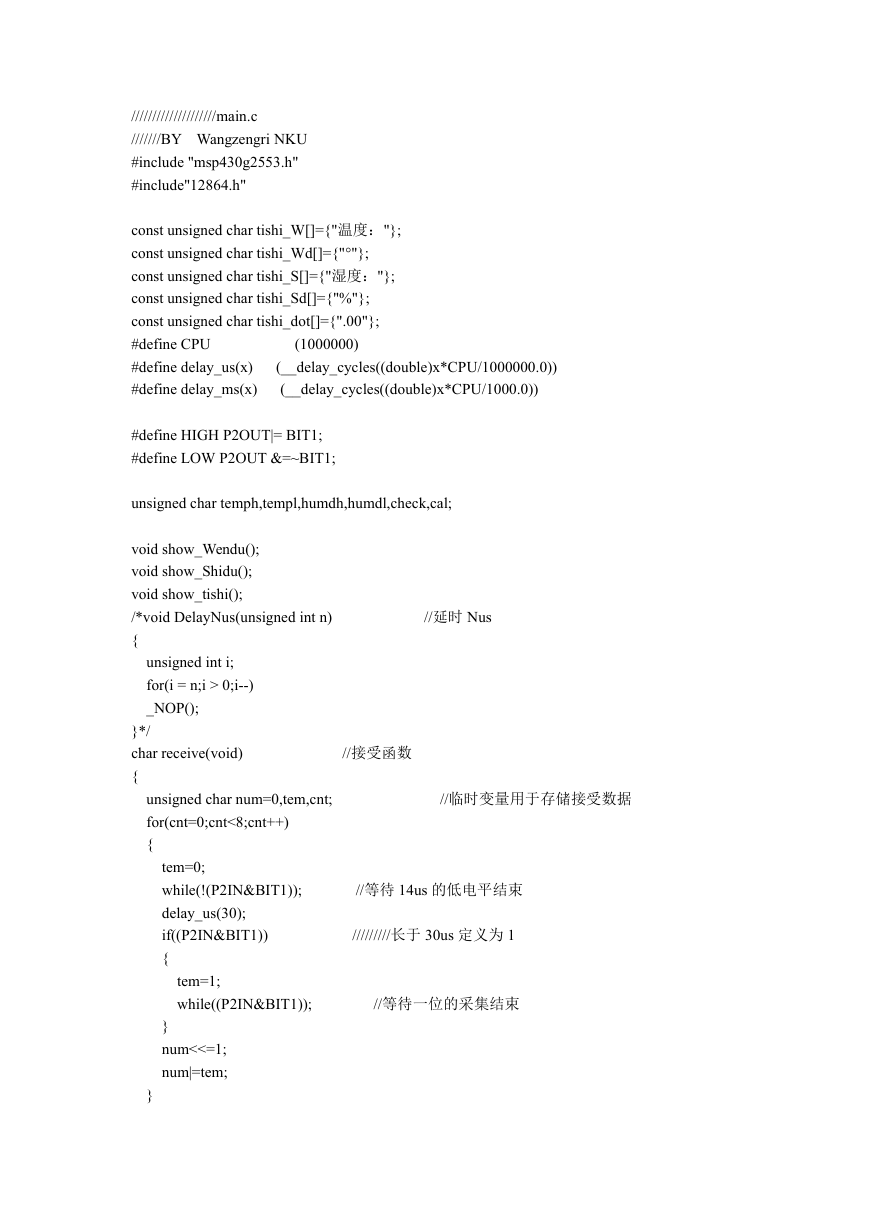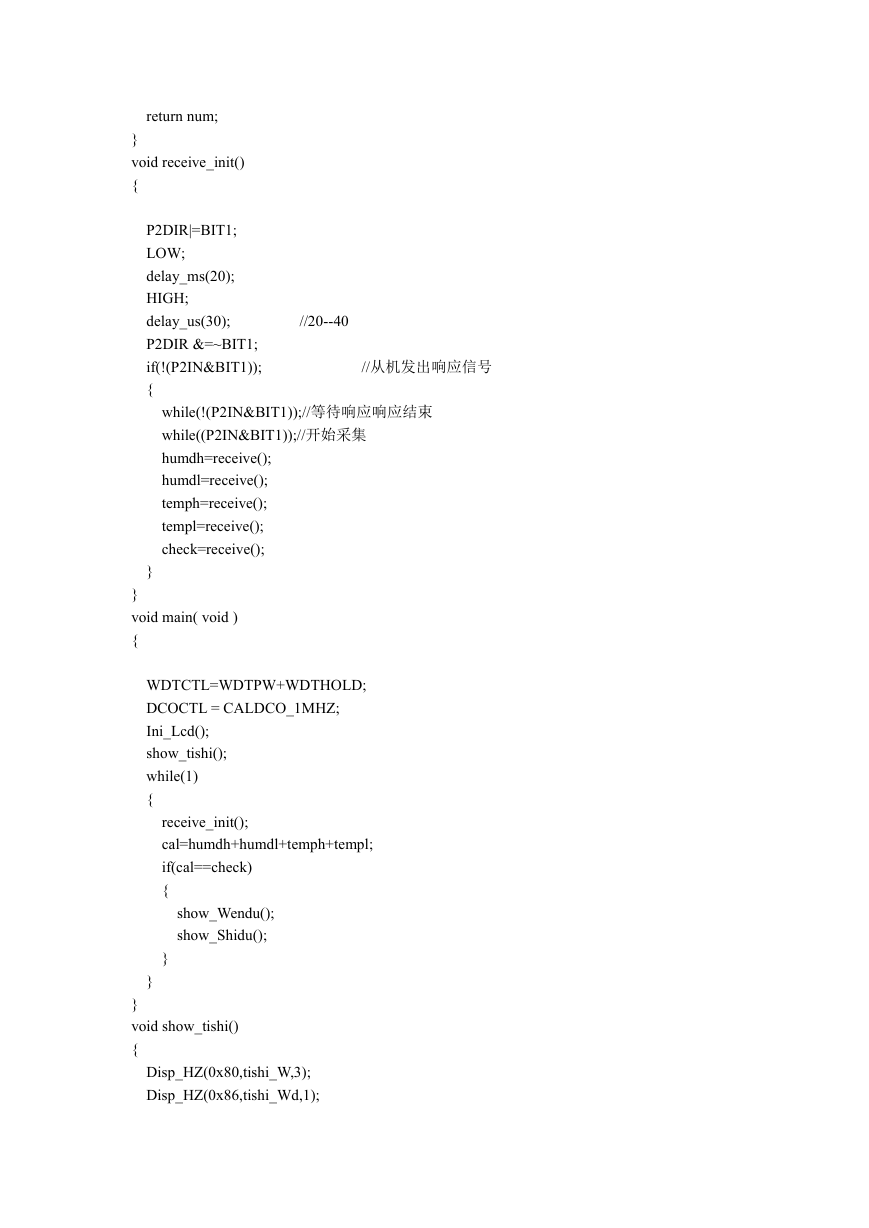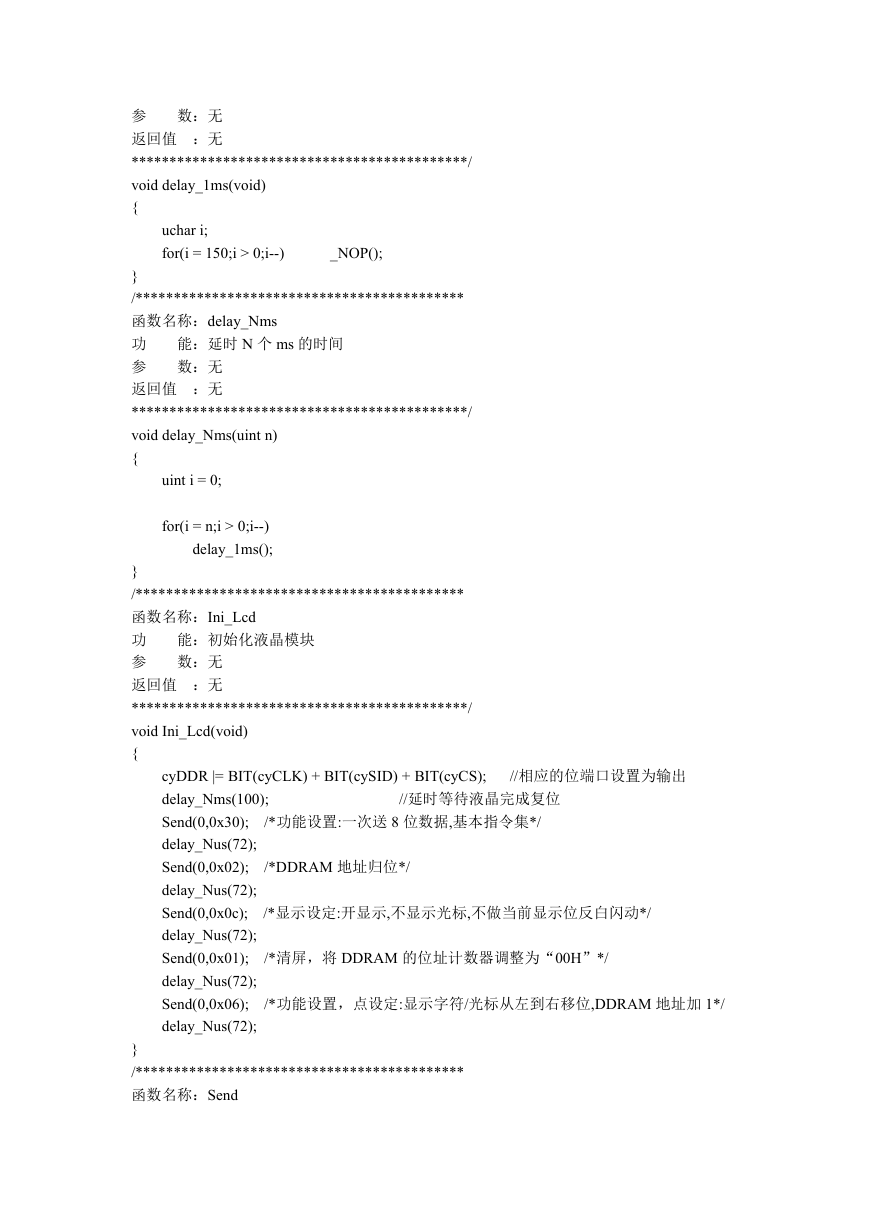////////////////////main.c
///////BY Wangzengri NKU
#include "msp430g2553.h"
#include"12864.h"
const unsigned char tishi_W[]={"温度:"};
const unsigned char tishi_Wd[]={"°"};
const unsigned char tishi_S[]={"湿度:"};
const unsigned char tishi_Sd[]={"%"};
const unsigned char tishi_dot[]={".00"};
#define CPU
#define delay_us(x)
#define delay_ms(x)
(1000000)
(__delay_cycles((double)x*CPU/1000000.0))
(__delay_cycles((double)x*CPU/1000.0))
#define HIGH P2OUT|= BIT1;
#define LOW P2OUT &=~BIT1;
unsigned char temph,templ,humdh,humdl,check,cal;
void show_Wendu();
void show_Shidu();
void show_tishi();
/*void DelayNus(unsigned int n)
{
unsigned int i;
for(i = n;i > 0;i--)
_NOP();
}*/
char receive(void)
{
unsigned char num=0,tem,cnt;
for(cnt=0;cnt<8;cnt++)
{
tem=0;
while(!(P2IN&BIT1));
delay_us(30);
if((P2IN&BIT1))
{
tem=1;
while((P2IN&BIT1));
}
num<<=1;
num|=tem;
}
//延时 Nus
//接受函数
//临时变量用于存储接受数据
//等待 14us 的低电平结束
/////////长于 30us 定义为 1
//等待一位的采集结束
�
return num;
}
void receive_init()
{
P2DIR|=BIT1;
LOW;
delay_ms(20);
HIGH;
delay_us(30);
P2DIR &=~BIT1;
if(!(P2IN&BIT1));
{
//20--40
//从机发出响应信号
while(!(P2IN&BIT1));//等待响应响应结束
while((P2IN&BIT1));//开始采集
humdh=receive();
humdl=receive();
temph=receive();
templ=receive();
check=receive();
}
}
void main( void )
{
WDTCTL=WDTPW+WDTHOLD;
DCOCTL = CALDCO_1MHZ;
Ini_Lcd();
show_tishi();
while(1)
{
receive_init();
cal=humdh+humdl+temph+templ;
if(cal==check)
{
show_Wendu();
show_Shidu();
}
}
}
void show_tishi()
{
Disp_HZ(0x80,tishi_W,3);
Disp_HZ(0x86,tishi_Wd,1);
�
Disp_HZ(0x88,tishi_S,3);
Disp_HZ(0x8e,tishi_Sd,1);
}
void show_Wendu()
{
Disp_SZ(0x83,temph);
Disp_HZ(0x84,tishi_dot,2);
//Disp_SZ(0x84,templ);
}
void show_Shidu()
{
Disp_SZ(0x8b,humdh);
Disp_HZ(0x8c,tishi_dot,2);
//Disp_SZ(0x8c,humdl);
}
//12864.c
#include
typedef unsigned int uint;
typedef unsigned char uchar;
#define BIT(x)
(1 << (x))
const uchar numtable[]={"0123456789"};
void Send(uchar type,uchar transdata);
/**********液晶控制 IO 的宏定义*************/
#define cyCS
#define cySID
#define cyCLK
#define cyPORT
#define cyDDR
//P1.0,片选信号
//P1.1,串行数据
//P1.2,同步时钟
0
1
2
P1OUT
P1DIR
能:延时 N 个 us 的时间
数:n--延时长度
/*******************************************
函数名称:delay_Nus
功
参
返回值 :无
********************************************/
void delay_Nus(uint n)
{
uchar i;
for(i = n;i > 0;i--)
_NOP();
}
/*******************************************
函数名称:delay_1ms
功
能:延时约 1ms 的时间
�
数:无
参
返回值 :无
********************************************/
void delay_1ms(void)
{
uchar i;
for(i = 150;i > 0;i--)
_NOP();
}
/*******************************************
函数名称:delay_Nms
能:延时 N 个 ms 的时间
功
参
数:无
返回值 :无
********************************************/
void delay_Nms(uint n)
{
uint i = 0;
for(i = n;i > 0;i--)
delay_1ms();
}
/*******************************************
函数名称:Ini_Lcd
能:初始化液晶模块
功
参
数:无
返回值 :无
********************************************/
void Ini_Lcd(void)
{
/*DDRAM 地址归位*/
cyDDR |= BIT(cyCLK) + BIT(cySID) + BIT(cyCS);
delay_Nms(100);
Send(0,0x30);
delay_Nus(72);
Send(0,0x02);
delay_Nus(72);
Send(0,0x0c);
delay_Nus(72);
Send(0,0x01);
delay_Nus(72);
Send(0,0x06);
delay_Nus(72);
}
/*******************************************
函数名称:Send
//延时等待液晶完成复位
/*功能设置:一次送 8 位数据,基本指令集*/
//相应的位端口设置为输出
/*显示设定:开显示,不显示光标,不做当前显示位反白闪动*/
/*清屏,将 DDRAM 的位址计数器调整为“00H”*/
/*功能设置,点设定:显示字符/光标从左到右移位,DDRAM 地址加 1*/
�
功
参
能:MCU 向液晶模块发送 1 一个字节的数据
数:type--数据类型,0--控制命令,1--显示数据
transdata--发送的数据
返回值 :无
********************************************/
void Send(uchar type,uchar transdata)
{
uchar firstbyte = 0xf8;
uchar temp;
uchar i,j = 3;
if(type) firstbyte |= 0x02;
cyPORT |= BIT(cyCS);
cyPORT &= ~BIT(cyCLK);
while(j > 0)
{
if(j == 3) temp = firstbyte;
else if(j == 2) temp = transdata&0xf0;
else
temp = (transdata << 4) & 0xf0;
for(i = 8;i > 0;i--)
{
cyPORT |= BIT(cySID);
cyPORT &= ~BIT(cySID);
if(temp & 0x80)
else
cyPORT |= BIT(cyCLK);
temp <<= 1;
cyPORT &= ~BIT(cyCLK);
}
//三个字节之间一定要有足够的延时,否则易出现时序问题
if(j == 3) delay_Nus(600);
else
delay_Nus(200);
j--;
}
cyPORT &= ~BIT(cySID);
cyPORT &= ~BIT(cyCS);
}
/*******************************************
函数名称:Clear_GDRAM
能:清除液晶 GDRAM 内部的随机数据
功
参
数:无
返回值 :无
�
********************************************/
void Clear_GDRAM(void)
{
uchar i,j,k;
Send(0,0x34);
i = 0x80;
for(j = 0;j < 32;j++)
{
//打开扩展指令集
Send(0,i++);
Send(0,0x80);
for(k = 0;k < 16;k++)
{
Send(1,0x00);
}
}
i = 0x80;
for(j = 0;j < 32;j++)
{
Send(0,i++);
Send(0,0x88);
for(k = 0;k < 16;k++)
{
Send(1,0x00);
}
}
Send(0,0x30);
//回到基本指令集
}
/*******************************************
函数名称:Disp_HZ
功
参
能:显示汉字程序
数:addr--显示位置的首地址
pt--指向显示数据的指针
num--显示数据的个数
返回值 :无
********************************************/
void Disp_HZ(uchar addr,const uchar * pt,uchar num)
{
uchar i;
Send(0,addr);
for(i = 0;i < (num*2);i++)
Send(1,*(pt++));
}
�
能:在整个屏幕上画一个图片
数:ptr--指向保存图片位置的指针
/*******************************************
函数名称:Draw_PM
功
参
返回值 :无
********************************************/
void Draw_PM(const uchar *ptr)
{
uchar i,j,k;
Send(0,0x34);
i = 0x80;
for(j = 0;j < 32;j++)
{
//打开扩展指令集
Send(0,i++);
Send(0,0x80);
for(k = 0;k < 16;k++)
{
Send(1,*ptr++);
}
}
i = 0x80;
for(j = 0;j < 32;j++)
{
Send(0,i++);
Send(0,0x88);
for(k = 0;k < 16;k++)
{
Send(1,*ptr++);
}
}
Send(0,0x36);
Send(0,0x30);
//打开绘图显示
//回到基本指令集
}
/*******************************************
函数名称:Draw_TX
功
参
能:在液晶上描绘一个 16*16 的图形
数:Yaddr--Y 地址,
Xaddr--X 地址
dp--指向保存图形数据的指针
返回值 :无
********************************************/
void Draw_TX(uchar Yaddr,uchar Xaddr,const uchar * dp)
{
�
uchar j;
uchar k = 0;
Send(0,0x34);
for(j = 0;j < 16;j++)
{
Send(0,Yaddr++);
Send(0,Xaddr);
Send(1,dp[k++]);
Send(1,dp[k++]);
}
Send(0,0x36);
Send(0,0x30);
//使用扩展指令集,关闭绘图显示
//Y 地址
//X 地址
//送两个字节的显示数据
//打开绘图显示
//回到基本指令集模式
}
/*******************************************
函数名称:Disp_SZ
功
参
能:显示一个两位数字
数:addr--显示地址
数字--显示的数字
返回值 :无
********************************************/
void Disp_SZ(uchar addr,uchar shuzi)
{
uchar tmp0,tmp1;
tmp0 = shuzi / 10;
tmp1 = shuzi % 10;
Send(0,addr);
Send(1,numtable[tmp0]);
Send(1,numtable[tmp1]);
}
//12864.h
void Send(unsigned char type,unsigned char transdata);
void Ini_Lcd(void);
void Clear_GDRAM(void);
void Disp_HZ(unsigned char addr,const unsigned char * pt,unsigned char num);
void Draw_PM(const unsigned char *ptr);
void Draw_TX(unsigned char Yaddr,unsigned char Xaddr,const unsigned char * dp) ;
void Disp_SZ(unsigned char addr,unsigned char shuzi);
void delay_Nus(unsigned int n);
void delay_Nms(unsigned int n);
void delay_1ms(void);
�
















 2023年江西萍乡中考道德与法治真题及答案.doc
2023年江西萍乡中考道德与法治真题及答案.doc 2012年重庆南川中考生物真题及答案.doc
2012年重庆南川中考生物真题及答案.doc 2013年江西师范大学地理学综合及文艺理论基础考研真题.doc
2013年江西师范大学地理学综合及文艺理论基础考研真题.doc 2020年四川甘孜小升初语文真题及答案I卷.doc
2020年四川甘孜小升初语文真题及答案I卷.doc 2020年注册岩土工程师专业基础考试真题及答案.doc
2020年注册岩土工程师专业基础考试真题及答案.doc 2023-2024学年福建省厦门市九年级上学期数学月考试题及答案.doc
2023-2024学年福建省厦门市九年级上学期数学月考试题及答案.doc 2021-2022学年辽宁省沈阳市大东区九年级上学期语文期末试题及答案.doc
2021-2022学年辽宁省沈阳市大东区九年级上学期语文期末试题及答案.doc 2022-2023学年北京东城区初三第一学期物理期末试卷及答案.doc
2022-2023学年北京东城区初三第一学期物理期末试卷及答案.doc 2018上半年江西教师资格初中地理学科知识与教学能力真题及答案.doc
2018上半年江西教师资格初中地理学科知识与教学能力真题及答案.doc 2012年河北国家公务员申论考试真题及答案-省级.doc
2012年河北国家公务员申论考试真题及答案-省级.doc 2020-2021学年江苏省扬州市江都区邵樊片九年级上学期数学第一次质量检测试题及答案.doc
2020-2021学年江苏省扬州市江都区邵樊片九年级上学期数学第一次质量检测试题及答案.doc 2022下半年黑龙江教师资格证中学综合素质真题及答案.doc
2022下半年黑龙江教师资格证中学综合素质真题及答案.doc